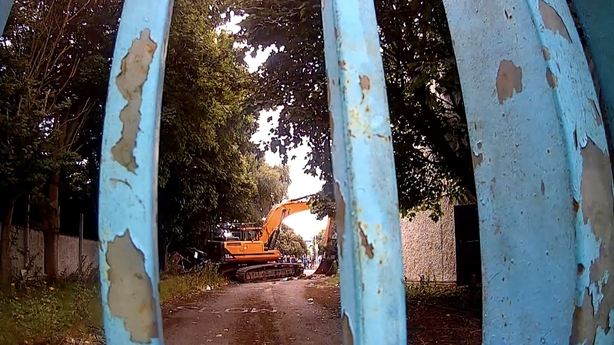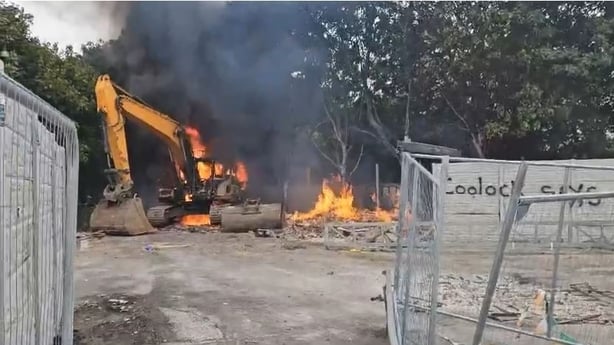For the past six months, Barry O'Kelly of RTÉ Investigates has been filming at protests against accommodation for migrants. Tonight the documentary 'Inside the Protests’ is broadcast.
Featuring views from protesters, experts on policing and political movements, and individuals developing sites for accommodation, it documents how fierce opposition has developed at certain sites, and sometimes spun out of control.
On Monday 15 July, I was inside the former Crown Paints site in Coolock as one of the largest anti-immigration protests nationwide to date exploded into rioting.
Footage from body-worn cameras, fixed cameras located around the site and my hand-held camera, captured what happened over the subsequent hours, as protests turned violent and pictures of fires and clashes circulated around the world.
I had entered the site with Paul Collins, who owns the company leasing the site, before dawn.
"I think what will be interesting is what will happen in the next 24 to 48 hours," he told me. He was right to wonder.
The site entrance had been blocked for more than 100 days by protesters, who had set up a camp with wooden huts, couches, fridges and storage areas. The Department of Integration planned to accommodate 574 asylum seekers on the site, but the development by Mr Collins had been blocked since March due to the ongoing protests.

That morning, gardaí were coming to restore access for vehicles through the entrance.
It was the outcome agreed after months of meetings between Mr Collins and senior officers, during which he provided an affidavit about threats and intimidation of workers, the destruction of his cctv system and a fire bomb threat.
The plan to forcibly remove the blockade presented a significant security challenge.
At 3am that morning, garda public order teams turned up in large numbers to remove the camp and disperse several protesters who were 'on the night shift'.
Once access was secured, staff finally entered the site. Work began on re-installing the CCTV system, and new fencing was erected at the entrance by Mr Collins’s team.
At 5am, agitators turned up at the entrance. The comments they directed towards the black security guards were growing increasingly offensive and intimidating.
Despite this, by 6am there was no longer any visible Garda public order presence outside the site. The threats were now coming thick and fast. Cameras captured most of them.
One man told the security staff: "I'm going to find out where each and every one of youse live. Don’t think we won’t find you, cause we f**king will. I’ve found worse c***s than you."
Another man said: "You’ll get f**king shot here." Making a gesture of a gun pointed to his head, he said: "Bang, bang. That’s what happens."
The crowd at the entrance grew as the early morning wore on.

Another man said: "Go back to your country. The fences won't hold you. Dublin says no. Get the f**k out, you’re a different breed."
One man chanted a phrase frequently heard at protests: "Burn, baby burn" It proved to be a prophetic comment.
The security team and Mr Collins’ staff were standing nearby, and realising they were now essentially under siege.
They were making calls to gardaí looking for help. Despite this, just after 10am, agitators were able to pull down the newly-erected railings and enter the site.
Minutes later a petrol bomb was thrown into the site.
For the next hour, agitators – some armed with poles - roamed through the site, threatening and chasing after security workers, smashing windows, stealing beds, and most-visibly, setting fire to a digger.

As cameras rolled, a member of the security team was hit with a pole across the head. He was still falling in and out of consciousness when paramedics arrived.
Outside the site entrance - hours after calls had first been made about the growing violence - the Garda public order units eventually returned. It would be early evening before order was fully restored in the area.
Protests would continue nightly over the following days. The site has been set on fire multiple times since.
In a statement to RTÉ Investigates, An Garda Síochána said the policing operation undertaken in Coolock, as with any event involving public disorder, was "centred on a graduated approach and a strong tradition of policing by consent".
It said over 200 members were deployed during the operation and a full investigation is now underway including the review of 3,000 hours of CCTV footage with 34 arrests having been made to date. It added three Gardaí were injured on the day.
While the protests were at their height, Paul Collins left the country for his own safety, and that of his family.
At his factory in Nenagh, Co Tipperary, he produces modular homes, many of which are earmarked for at the former Crown Paints site. These are lego-like plug-and-play structures that can be assembled within days.
Mr Collins has already installed houses for asylum seekers elsewhere, but he says the opposition to his plan for the north Dublin site has been different.
"I'm not a guy that you easily frighten, but it's definitely more frightening," he said.
"I don't understand in the sense of, you know, the hands on, the hands-off approach [by the gardaí]. Is there a law or is there not?"

The former Crown Paints site is just one of 200 around the country designated for accommodating asylum applicants by the International Protection Accommodation Service (IPAS).
Some 400 people have been arriving weekly since February seeking international protection - almost double last year's figure. This year alone, a total of 25,000 people are expected to make applications for asylum, bringing the total number since 2019 to 50,000.
With the growing numbers comes a growing demand for temporary accommodation.
The problem is that many local communities do not want it in their areas, for varying reasons.
As in Coolock, at protests nationwide we found people with genuine concerns about the availability of local services – for them, and asylum seekers - and others with more hardline outlooks.
Watch: Reporter Barry O'Kelly on Thursday's One O'Clock News
We need your consent to load this rte-player contentWe use rte-player to manage extra content that can set cookies on your device and collect data about your activity. Please review their details and accept them to load the content.Manage Preferences
In that mix of concerns and a vacuum of information, a variety of 'citizen journalists' and fringe activists have stepped in, often stirring false claims and vitriol. In Coolock, it is no different.
Many local community members feel there has been a lack of meaningful communication, and the violence has been stoked by unfounded claims which were circulated, claiming that 1,000 men were going to be housed at the former Crown Paints site. The Department of Integration places that number at 574, and it is understood that these are to include women and children.
Amidst that, the violence grew, culminating – so far – in the events we witnessed on 15 July.
Some experts have called for law and order reform to deal with the issue. However, others have warned the problems run deeper than that.
"I would resist reducing it to a public order element," Dr Barry Cannon of the Department of Sociology in Maynooth University said.
"There is a very large amount of people which feel very disenfranchised and cannot be ignored in this battle for hearts and minds."
Watch the full documentary 'RTÉ Investigates: Inside the Protests' tonight on RTÉ One at 9.35pm and RTÉ Player.





